Mongolia Birding Tour
 16-30th June 2026: Mongolia birding tour highlights include Henderson’s Ground Jay, White-naped Crane, Oriental Plover, Mongolian Lark, Azure Tit, Swan Goose, Pere David’s Snowfinch, Black-billed Capercaillie, Altai Snowcock, Amur Falcon, Pallas’s Sandgrouse, Himalayan Griffon, Mongolian Accentor, Relict Gull, Godlewski’s Bunting, Guldenstadt’s Redstart, Asian Dowitcher, Stejneger’s Scoter – £4425
16-30th June 2026: Mongolia birding tour highlights include Henderson’s Ground Jay, White-naped Crane, Oriental Plover, Mongolian Lark, Azure Tit, Swan Goose, Pere David’s Snowfinch, Black-billed Capercaillie, Altai Snowcock, Amur Falcon, Pallas’s Sandgrouse, Himalayan Griffon, Mongolian Accentor, Relict Gull, Godlewski’s Bunting, Guldenstadt’s Redstart, Asian Dowitcher, Stejneger’s Scoter – £4425

Trip Details
- Dates: 16th – 30th June 2026
- Cost: £4425
- Single Supplement: £520
- Deposit: £550
- Tour length: 15 Days (13 days birding)
- Min/Max group size: 5 / 10
- Start/Finish: Ulaanbataar
- Tour Type: Birding
- Photo Opps: Good
- Physical Classification: Fairly Easy
- Leaders: Nick Upton & Local Guides
If you have any questions about this trip please feel free to ask by contacting us at info@calidrisbirdingtours.com
Mongolia Birding
It is not every day that there is the opportunity to go birding in a country that is almost entirely undeveloped, consisting of some of the largest open spaces in the world. Mile after mile of steppe, grazed by the herds of the nomads for centuries, amazing expanses of wetlands popping up in any habitat type, rolling, open taiga on the northern hills and dry, thorny scrublands against the backdrop of enormous sand dunes and the Altai mountains. Birding in Mongolia is a real adventure and a throwback to days gone by.
Mongolia has characteristics of Central and Eastern Asia as well as Europe, making for a diverse and interesting avifauna that include key Central Asian species, rare European breeders and exciting East Asian migrants. The numbers and variety of birds is a surprising strength of this trip but those key Mongolian birds are the ones that will form the focus of our attention whether birding in steppe, wetlands, taiga, mountains or desert. In such a wild and untamed land travel and accommodation can provide a logistical challenge but comfortable ger camps will form the bulk of our accommodation and sites that require the minimum of travel have been selected so that we can enjoy being immersed in the landscape with the most comfort and convenience that can be provided.
For birders who like to see birds on their breeding grounds, in full song and activity then this tour ticks those boxes. Seeing shy species such as Chinese Bush Warbler performing and Siberian Rubythroat in full song is a rare treat for most birders while locating species such as Black-billed Capercaillie, Stejneger’s Scoter, Mongolian Lark, White-naped Crane, Henderson’s Ground Jay, Altai Snowcock and Azure Tit should stick long in the memory. For those that enjoy an identification challenge and to learn about a difficult group of birds there will be a good selection of singing Phylloscopus warblers to get to grips with. Any birders who love raptors will not be disappointed in Mongolia with Saker Falcon, Steppe Eagle, Amur Falcon, Cinereous Vulture and Lammergeier just a few of the species we can look forward to. Add amazing scenery, a supporting cast of finches, wildfowl and woodpeckers and it is clear that this is a birding tour to be excited about.
Day 1, Arrival – 16th June 2026
Arrival in Ulaanbataar, the capital city of Mongolia. You will arrive at Chinggis Khaan International Airport and transfer a short distance to a comfortable hotel to get a good night’s sleep before this Mongolia birding tour birding starts.
Days 2-3, Terelj National Park – 17-18th June 2026

We begin our adventure in Mongolia by making the journey to Gorkhi-Terelj National Park, exchanging the city for hills and boreal woodland, otherwise known as taiga. Along the way we will pass the enormous Chinggis Khaan memorial statue, so we will make a short stop and take a few photos of this impressive edifice. Entering this habitat patchwork will bring us a good number of bird species to start with and, indeed, there are some real specialities to look for here. There are a few game birds awaiting us including Daurian Partridge, which is quite common here, along with the more secretive Hazel Grouse and Black Grouse. However, our focus will be very much on finding the impressive Black-billed Capercaillie. This massive beast is not easy to locate but if we put in the effort, and cover a lot of ground on foot, we should be in luck. This impressive bird should be a real highlight of this Mongolia birding tour.
Looking for these exciting species will put us in the right habitat for a lot of other birds, including many East Asian migrants that sometimes turn up in Europe. The trees should be alive with the songs of several species of Phylloscopus warblers including the smart Pallas’s Leaf Warbler and the more sombre-looking Hume’s Leaf Warbler with its peculiar song. Add to this Yellow-browed Warbler, Dusky Warbler, Arctic Warbler and Two-barred Warbler and you have a real collection of these difficult-to-identify birds. At this time of the year they will be in song, though, which will make things easier. On its wintering grounds Chinese Bush Warbler is almost impossible to see but when it is breeding it will sit up and sing for us, allowing us to study this difficult species. Wet areas will hold vegetation that is used by Paddyfield Warbler and Oriental Reed Warbler.
Some exciting Woodpeckers are in store for us here too. Massive Black Woodpecker will be found flying from tree to tree while the drumming of Eurasian Three-toed Woodpecker will alert us to its presence; this is a great place to catch up with this species with a wide, but thinly distributed, range. There should also be White-backed Woodpecker for us to enjoy as well as both Lesser and Greater Spotted Woodpeckers too. This is also where we expect to find another smart little bird in the form of Pine Bunting. Calling from the tops of small trees we should be able to spot this attractive species. Ortolan Bunting and Black-faced Bunting will also entertain us while raptors here include Northern Goshawk.
Days 4-5, Gun Galuut National Park – 19-20th June 2026
Leaving one ger camp for another our journey will take us to the beautiful river valleys and lakes of Gun Galuut Nature Reserve, set in the sort of scenery that one expects of the Mongolian wilderness. Our ger camp is right within this spectacular area of hills and wetlands, giving us a great base for exploring the surrounding area.
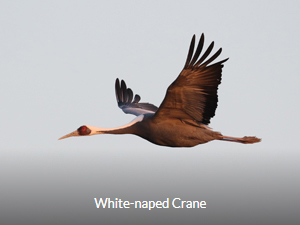
One of the main reasons for visiting this location is to see elegant White-naped Cranes. This is one of the most beautiful of the world’s crane species and it will be something to remember to watch them on their breeding grounds; despite the large number of other species it may be hard to take our eyes off of them. These wetlands play host to lots of other interesting birds too including Black Stork, Eurasian Spoonbill and Demoiselle Crane and if we are very lucky there could be a chance of Siberian Crane; fingers crossed!
Of course, in a wetland there will be wildfowl and this is an excellent place to photograph Swan Goose and to find Bar-headed Geese on their breeding grounds on the northern side of their trans-himalayan migration. Along with common species such as Common Goldeye, Northern Pintail and Ruddy Shelduck we will also be searching for breeding Stejneger’s Scoter, something to anticipate with excitement. This location is also a great place for us to see waders on their breeding grounds. Northern Lapwing is common but always a nice bird as are Pied Avocet and Black-winged Stilt. The top prize for us here though is Asian Dowitcher. This is a rare bird here so we will have to search for this fantastic bird while we should be able to enjoy species that include Marsh Sandpiper, Kentish Plover and Ruff in all their breeding finery.
Reed beds and emergent vegetation are also of interest to us with cryptic species such as Paddyfield Warbler, Oriental Reed Warbler and Lanceolated Warbler singing away. These reedy areas should also give us the chance to compare dainty Pallas’s Reed Buntings alongside the chunkier Common Reed Bunting as well as hearing their song. Mongolian Lark is one of the specialities of this wonderful country and if we haven’t already seen them, then we surely will add them to our list here. Other birds filling the air with their song will include Eurasian Skylark, Citrine Wagtail, Blyth’s Pipit and Isabelline Wheatear. Common Sand Martin and Pale Martin will give us some difficulties in separating them but the Daurian Jackdaws that follow us from Ulanbataar will be easier!
Gulls are perhaps not every birder’s favourites but here we have a very good chance of finding the very scarce Relict Gull on its breeding grounds. It will probably take some searching but it will be no hardship to scan through big numbers of birds in search of it. With effort we have a very good chance of finding the small numbers of Relict Gulls that are here.
This area gives us another chance at two scarce raptors in the shape of Greater Spotted Eagle and Eastern Imperial Eagle. We can also expect to see Hen Harrier and Eastern Marsh Harrier hunting over the wetlands. This area should provide us with some of the richest birding of the trip with a wide range of species, some of which will be familiar, others of which will be more exotic.
Day 6, Tuul River – Ulaanbataar – 21st June 2026
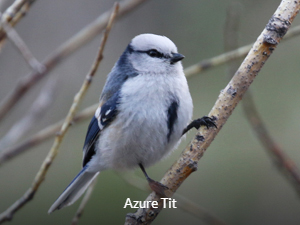
In the morning we will have time to do some more birding in the area to look for any rare targets that we may not have seen so far but we will leave fairly early to drive back towards Ulaanbaatar, with birding stops along the way. Eventually we will drive through what will certainly be the least impressive landscape we see in Mongolia but once we get to the Tuul river we find ourselves in a lovely location on the outskirts of Ulaanbataar. Although we will drive through areas of construction and urban sprawl the birding is in an area of riverine habitats that include farmland, willow scrub, pools, streams and, of course, the river itself. This mosaic of habitats will provide us with good views of a much-wanted bird in the form of the cute little Azure Tit; this is a superb little bird.
A nice selection of Eurasian species occur here with some of the commoner birds being the smart Daurian Jackdaw, Black-eared Kite, White Wagtail, Goosander and Red-billed Chough. However, we will search the reeds and willows for some highly sought-after birds including the lovely White-capped Penduline Tit and Long-tailed Rosefinch. These two little beauties will be our main focus along with Azure Tit here but we will not ignore other regional specialities such as Azure-winged Magpie, White-cheeked Starling and Red-throated Thrush.
The river and pools will hold some birds of interest too with wildfowl including Whooper Swan, Chinese Spot-billed Duck, Mandarin Duck, Ruddy Shelduck and our first chance of seeing Swan Goose. We will enjoy some relaxed birding here with species as diverse as Pacific Swift, Great Crested Grebe, Cinereous Vulture and Hawfinch. Once we have had good views of our main targets here and enjoyed the birding up until late afternoon we will stay in a hotel very close by for a night in a pleasant hotel in preparation for an internal flight the next morning.
Day 7, Flight to Hovd – Har-su Lake – 22nd June 2026
There may be time for a little more birding close to the hotel before we transfer to Chinggis Khaan International Airport for our flight to the town of Hovd in western Mongolia, expecting to arrive in time for lunch. In the afternoon, after checking into our hotel, we will drive out to Har-us Lake, an area of steppe wetlands with a stunning snow-topped mountain backdrop; a wonderful setting for birding in.
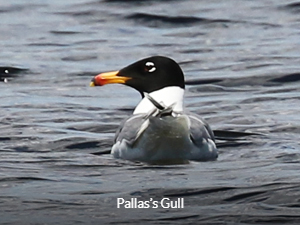
We will concentrate on wetland birds here with White-headed Duck being one of the key targets for us. There is a good chance of seeing beautiful Bar-headed Geese again here and elegant Demoiselle Cranes striding around in the wet grassland and lake edges. The magnificent Pallas’s Gull can be found here too; one of Asia’s most impressive gulls along with another regional speciality Mongolian Gull. A wide array of terns should be found here too including White-winged Terns which are very striking in breeding plumage and there will be another chance of seeing larger waterbirds such as Black Stork and Eurasian Spoonbill. The reedy fringes of the lake harbour a number of “little brown jobs” uttering a selection of scratchy and reeling songs including Pallas’s Grasshopper Warbler, Savi’s Warbler andPaddyfield Warbler, all rather easier to see on their breeding grounds than on their wintering areas.
In the grasslands around the lake itself there exist a wide range of passerines for us to search for too. Larks feature here with the song of Eurasian Skylark emanating from the sky, with Crested Lark joining in the song. Asian Short-toed Lark can be found here too and “Mongolian” Horned Lark adds some striking markings to the brown, streaky theme of the other larks. Drier areas in this region contain areas of shrubby vegetation and bare ground and we can search for Asian Desert Warbler here, skulking around in the undergrowth, most likely to be seen in the late afternoon. Mongolian Finches can usually be seen here too, often feeding on the ground or drinking from wet patches.
After a good afternoon of birding we return to our hotel for dinner.
Days 8-9, Jargalant Mountains – 23-24th June 2026
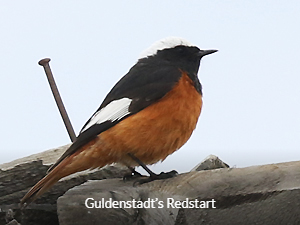
After an early breakfast we plunge into the awesome scenery of the Jargalat Mountains where we will spend the next few days searching for high altitude species. Birding within gorges, alpine meadows, coniferous forests and upland lakes one of our prime targets, and possibly the hardest to find, in Altai Snowcock; this bird calls from rocky ridges and other exposed areas and we will attempt to spot them as they do this. Rock Ptarmigan can be found in similar areas too and this is usually an excellent place to see a range of raptors including huge birds such as Himalayan Griffon, Cinereous Vulture and the iconic Lammergeier. Saker Falcon can be common in this habitat and another good bird to connect with is Upland Buzzard, much longer-winged than most other Eurasian Buzzards.
Up at the highest altitudes the beautiful Guldenstadt’s Redstart holds territories and is always a delight to see but there are plenty of other passerines here too including White-winged Snowfinch, Altai Accentor and the endemic Mongolian (Kozlov’s) Accentor, foraging on grassy patches in the rocky uplands. A little lower down areas of shrubby woodland on the hillsides are the home of various species such as Sulphur-bellied Warbler, smart Pine Bunting, Common Rockthrush and the impressive Barred Warbler. We will also scan rockfaces for Wallcreeper, one of the most delightful birds of the mountains and a much-hoped-for bird throughout its range.
A selection of buntings occupy their own vegetative and altitudinal niches on the mountains resulting in a good number of species to look for including Godlewski’s Bunting, Grey-necked Bunting and Meadow Bunting. Birds are the focus of this birding tour to Mongolia of course but we will also be looking carefully for mammals that will certainly include pikas and marmots but the prime hope will be Snow Leopard. Two days in this area gives us time to devote to the search for all of these exciting species.
Days 10-11, Homyn Tal – 25-26th June 2026

Leaving the Jargalat Mountains we transfer to Homyn Tal, a vast area of steppe featuring some incredible areas of visually stunning sand dunes. Staying, again, in a ger camp we will be immersed in this landscape and take drives into this habitat to search for some exciting birds such as Pallas’s Sandgrouse, which we can find visiting waterholes or feeding on the ground, but this will hopefully be eclipsed by Mongolian (Henderson’s) Ground Jay. This awesome bird can often be found calling from the tops of bushes in the early morning, before things get hot, and feeding on the ground. At this time of the year the Ground Jays should be feeding fledged young and so be quite active, making finding them easier.
Striking Lesser Kestrels are found in this habitat too and in the right patches of habitat we should be able to find Red-throated Thrush. However, this area is one with some interesting mammals too and we will spend some time trying to locate the incredible Saiga, an antelope with a short trunk-like nose as well as reintroduced Takhi, or Przewalski’s Horse. Our time here will be spent looking for the specialities of the area, particularly Henderson’s Ground Jay, as well as more general birding.
Days 12-13, Margaz Mountains – Bayan Nuur – 27-28th June 2026

Our time in this area will be spent exploring a variety of habitats that include wonderful bird-rich wetlands, massive sand dunes, verdant oases and granite tors set in mountain scenery. The lake of Bayan Nuur is one of the most bird-rich areas of Mongolia and it will provide us with another chance of seeing Swan Goose and Stejneger’s Scoter as well as breeding Black-throated Loons. However, one key species that has become rare everywhere it occurs is Pallas’s Fish Eagle and here we have a very real chance of finding this impressive raptor while Steppe Eagle and White-tailed Eagle should be more numerous. This area of wetlands gives us another chance to find one of the rarer wading birds, Asian Dowitcher, as well as commoner species including Greater Sand Plover and Long-toed Stint. beared Reedling can be found in the reedy areas around the lake with Short-eared Owls hunting nearby.
The more mountainous areas provide us with another chance to find species such as Mongolian Accentor, Pere David’s Snowfinch and Grey-necked Buntings while the arid areas here give us a backup site for Mongolian Ground Jaym Asian Desert Warble, a wide range of larks and Eurasian Eagle Owl in areas of craggy rocks. Mammals are abundant in this region too with a by now familiar selection of gerbils, hamsters and other small rodents but there is also a very real chance of finding Pallas’s Cat if we are lucky.
Day 14, Ulaangom – Ulaanbataar – 29th June 2026
Leaving our ger camp for the final time we take a scenic drive through Mongolia’s incredible landscape towards the town of Ulaangom. Along the way we will make birding stops to take any opportunities to get better views/photos of any species we may see and there should be time to check out the edges of Uvs Lake for any wetland birds that we may not have yet found. Our flight back to Ulaanbataar is scheduled for the evening.
Our final dinner together will conclude this Central Mongolia birding tour.
Day 15, Departure – 30th June 2026
Transfer from the hotel to Chinggis Khaan International Airport for our flights leaving Mongolia.
The following is a list of species that we have a good chance of seeing on this Central Mongolia birding tour based on the experience of previous visits. This is not a complete list of birds that we will be looking for but they are some of the main highlights based on how memorable or how range-restricted they are. Although we will be looking for all the birds of Mongolia these are many of the highlights that we will be putting our efforts into finding. Of course, these are wild birds and we cannot guarantee that we will see them all although we do expect to find a high proportion of them.
- Black Grouse – Lyrurus tetrix
- Hazel Grouse – Tetrastes bonasia
- Black-billed Capercaillie – Tetrao parvirostris
- Altai Snowcock – Tetraogallus altaicus
- Daurian Partridge – Perdix dauurica
- Bar-headed Goose – Anser indicus
- Swan Goose – Anser cygnoides
- Stejneger’s Scoter – Melanitta stejnegeri
- Falcated Duck – Mareca falcata
- Mandarin Duck – Aix galericulata
- Eastern (Chinese) Spotbilled Duck – Anas zonorhyncha
- Black Stork – Ciconia nigra
- Lammergeier – Gypaetus barbatus
- Himalayan Griffon – Gyps himalayensis
- Cinereous Vulture – Aegypius monachus
- Steppe Eagle – Aquila nipalensis
- Eastern Marsh Harrier – Circus spilonotus
- Long-legged Buzzard – Buteo rufinus
- Upland Buzzard – Buteo hemilasius
- White-naped Crane – Antigone vipio
- Demoiselle Crane – Grus virgo
- Oriental Plover – Charadrius veredus
- Asian Dowitcher – Limnodromus semipalmatus
- Pallas’s Sandgrouse – Syrrhaptes paradoxus
- Mongolian Gull – Larus mongolicus
- Relict Gull – Ichthyaetus relictus
- White-winged Tern – Chlidonias leucopterus
- Hill Pigeon – Columba rupestris
- Oriental Cuckoo – Cuculus optatus
- Ural Owl – Strix uralensis
- Eurasian Eagle Owl – Bubo bubo
- Black Woodpecker – Dryocopus martius
- Lesser Spotted Woodpecker – Dendrocopos minor
- White-backed Woodpecker – Dendrocopos leucotos
- Eurasian Three-toed Woodpecker – Picoides tridactylus
- Lesser Kestrel – Falco naumanni
- Amur Falcon – Falco amurensis
- Saker Falcon – Falco cherrug
- Isabelline Shrike – Lanius isabellinus
- Steppe Grey Shrike – Lanius pallidirostris
- Azure-winged Magpie – Cyanopica cyanus
- Henderson’s Ground Jay – Podoces hendersoni
- Daurian Jackdaw – Corvus dauuricus
- Azure Tit – Cyanistes cyanus
- White-crowned Penduline Tit – Remiz coronatus
- Pale Martin – Riparia diluta
- Asian Short-toed Lark – Alaudala cheleensis
- Mongolian Lark – Melanocorypha mongolica
- Horned Lark – Eremophila alpestris
- Lanceolated Warbler – Locustella lanceolata
- Chinese Bush Warbler – Locustella tacsanowskia
- Paddyfield Warbler – Acrocephalus agricola
- Oriental Reed Warbler – Acrocephalus orientalis
- Hume’s Leaf Warbler – Phylloscopus humei
- Pallas’s Leaf Warbler – Phyllsocopus proregulus
- Sulphur-bellied Warbler – Phylloscopus griseolus
- Asian Desert Warbler – Sylvia nana
- Barred Warbler – Sylvia nisoria
- Wallcreeper – Tichodroma muraria
- Red-throated Thrush – Turdus ruficollis
- Dark-sided Flycatcher – Muscicapa sibirica
- Siberian Rubythroat – Calliope calliope
- Red-flanked Bluetail – Tarsiger cyanurus
- Taiga Flycatcher – Ficedula albicilla
- (Eastern) Black Redstart – Phoenicurus ochruros (phoenicuroides)
- Daurian Redstart – Phoenicurus auroreus
- Guldenstadt’s Redstart – Phoenicurus erythrogastrus
- Pied Wheatear – Oenanthe pleschanka
- Isabelline Wheatear – Oenanthe isabellina
- Desert Wheatear – Oenanthe deserti
- Eurasian Rock Sparrow – Petronia petronia
- White-winged Snowfinch – Montifringilla nivalis
- Pere David’s Snowfinch – Pyrgilauda davidiana
- Brown Accentor – Prunella fulvescens
- Altai Accentor – Prunella himalayana
- Mongolian (Kozlov’s) Accentor – Prunella koslowi
- Long-tailed Rosefinch – Carpodacus sibiricus
- Beautiful Rosefinch – Carpodacus pulcherrimus
- Mongolian Finch – Eremopsaltria mongolica
- Twite – Linaria flavirostris
- Meadow Bunting – Emberiza cioides
- Godlewski’s Bunting – Emberiza godlewskii
- Grey-necked Bunting – Emberiza buchanani
- Ortolan Bunting – Emberiza hortulana
- Pine Bunting – Emberiza leucocephalos
- Pallas’s Reed Bunting – Schoeniclus pallasi
- Black-faced Bunting – Schoeniclus spodocephala
The map below indicates the main birding locations on this Central Mongolia birding tour. These are the main sites but there will be lots of birding stops between them as we travel.

1. Chinggis Khan International Airport
5. Gorkhi-Terelj National Park
2. Tuul River
6. Bayanzag
3. Delgerkhaan
7. Khongoryn Els
4. Gun Galuut Nature Reserve
Below are a selection of photos of birds that we have a good chance of seeing in Mongolia.

Steppe Eagle 
Saxaul Sparrow 
Lesser Kestrel 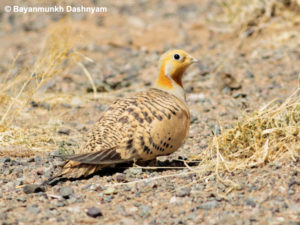
Pallas’s Sandgrouse 
Saker Falcon 
Red-billed Chough 
Pere David’s Snowfinch 
Black-eared Kite 
Bar-headed Goose 
Northern Lapwing 
Swan Goose 
White-winged Tern
All above photographs copyright Nick Upton/Calidris Birding Tours except where otherwise indicated.
Tour Details
Tour Cost: £4425
Single Supplement: £520
Included in the tour cost: All transportation within Mongolia including airport transfers and two internal flights plus road tolls; all services of expert local bird guides, trackers, drivers, camp staff and Calidris Birding Tours guide; all accommodation, meals and bottled drinking water plus entry fees to national parks and other protected areas.
Not included in the tour cost: International flights, travel insurance, entry visa, alcoholic/soft drinks, laundry, tips, mini bar items, phone calls from hotels or any other items of a personal nature. There are no camera fees expected for any of the areas we are visiting but if the Mongolian government should impose such fees at short notice then these will be at your own cost.
Accommodation: We use 3-4 star hotels in Ulanbataar. For the remaining nights we will stay at ger (the Mongolian word for yurt) camps. These are simple but clean and comfortable, with two to four beds within each one and a stove for heating. There are shared bathrooms and meals are eaten in a communal ger/building. This is the traditional Mongolian nomad’s accommodation and while they do not provide luxury they will provide a good night’s sleep in spectacular locations. We expect to have wifi on nights in Ulanbataar but not at ger camps for most of the tour. Single accommodation is possible but cannot be guaranteed.
Physical effort: This is not a particularly physically demanding tour in terms of walking. However, participants require reasonable level of fitness to be able to go on birding walks of several hours on fairly flat terrain. There will be one or two optional harder walks to locate a couple of target species if we cannot find them more easily. This tour has been designed to require far less travel than many other tours to Mongolia but participants should be able to deal with journeys over rough terrain.
Weather: Sunny but cool weather is normal at this time of year although rain showers are possible at times. After sunset the temperature is likely to drop considerably so that some warm clothing is required. Most of the time the temperature should be pleasant and there should be blue skies. However, participants will need to prepare for both cold and hot weather periods, as well as rain.
Food: Traditional Mongolian cuisine relies heavily on meat but years of catering to tourists means that vegetarian food is available. Vegetarians should notify us in advance so that some ger camps can order supplies in advance. Please notify us in advance if you have any food allergies so that these we can cater for these.
Tour Leaders

Nick Upton
Nick Upton has been birding since the age of seven and leading birding tours full-time since 2007. After travelling extensively in Asia he settled in Thailand in 1997, teaching English and science while establishing thaibirding.com. With a BSc (Hons) Wildlife & Countryside Conservation he is well placed to understand the ecology of birds as well as the conservation issues that affect them.
Nick is co-founder/director of Calidris Birding Tours.
While we will make every effort to adhere to the advertised itinerary, we reserve the right to make changes in the case of unforeseen circumstances that are beyond our control. These include problems with accessibility, flight schedule changes, national park closures, unseasonal weather events or any other reason that may demand an itinerary change.
Recommended Field Guide
 Birds of Mongolia
Birds of Mongolia
Published in 2019 this field guide was a long time in coming for this increasingly popular birding destination. Containing all the species we are likely to see on this Mongolia birding tour we highly recommend that all birders joining us on this tour obtain a copy of this field guide. This is the publication the guides will be using on this tour and obtaining a copy in advance of the tour will allow participants to familiarize themselves with the birds we will see in Mongolia.
The checklist that Calidris Birding Tours will issue for this trip will use IOC taxonomy while also referring to the taxonomy used within this field guide so that it is relevant to both.
Read our full review of the book here – Birds of Mongolia.
Terms and conditions: Please read the full Calidris Birding Tours terms and conditions which apply to the Mongolia Birding Tour.


